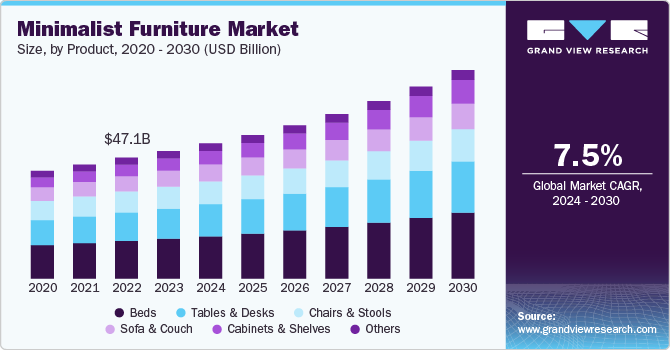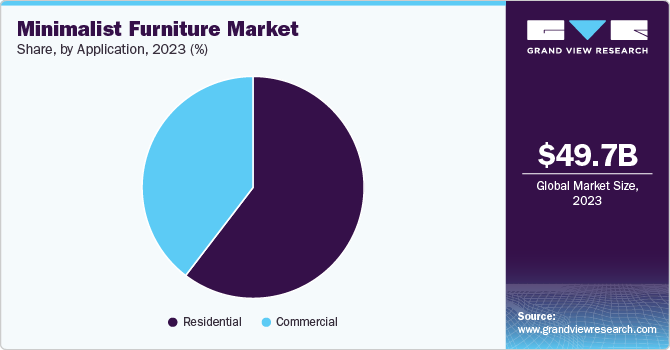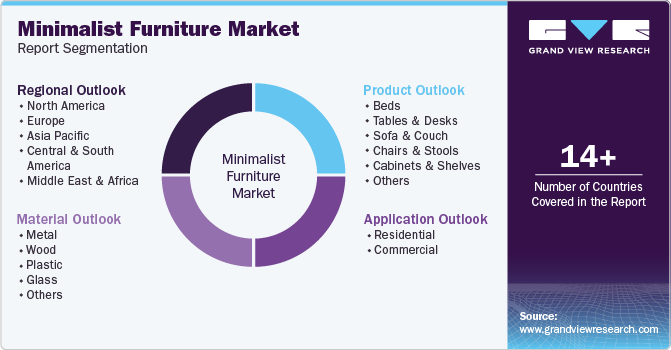- Home
- »
- Homecare & Decor
- »
-
Minimalist Furniture Market Size, Share, Growth Report 2030GVR Report cover
![Minimalist Furniture Market Size, Share & Trends Report]()
Minimalist Furniture Market Size, Share & Trends Analysis Report By Product (Beds, Tables & Desks), By Material (Metal, Wood, Plastic, Glass), By Application (Residential, Commercial), By Region, And Segment Forecasts, 2024 - 2030
- Report ID: GVR-4-68040-476-5
- Number of Report Pages: 110
- Format: PDF, Horizon Databook
- Historical Range: 2018 - 2023
- Forecast Period: 2024 - 2030
- Industry: Consumer Goods
Minimalist Furniture Market Size & Trends
The global minimalist furniture market size was estimated at USD 49.66 billion in 2023 and is expected to grow at a CAGR of 7.5% from 2024 to 2030. Minimalist spaces are increasingly associated with promoting calmness and mental clarity, as clean lines, open layouts, and lack of clutter create a serene environment that fosters relaxation. This aesthetic simplicity minimizes distractions, helping individuals feel more focused and at ease in living spaces. As a result, there is growing interest in minimalist furniture for its visual appeal and the sense of well-being it offers. By incorporating functional yet aesthetically pleasing designs that eliminate excess, minimalist furniture aligns with the desire for a balanced and peaceful home environment, further driving its popularity.

The integration of technology into minimalist furniture positively impacts its growth by catering to the increasing demand for smart, connected living spaces among tech-savvy consumers. Furniture with built-in features such as wireless charging stations, hidden storage for cables, and smart home integrations aligns perfectly with the minimalist ethos of reducing visible clutter while enhancing functionality. This seamless fusion of technology and design not only makes furniture more practical but also elevates its appeal to modern homeowners who value both aesthetic simplicity and advanced functionality. As a result, the growing trend toward smart homes further drives the demand for minimalist furniture, accelerating its market growth.
Minimalist furniture is highly attractive to budget-conscious consumers due to its affordability and practical design. Often characterized by simple structures, fewer materials, and clean lines, minimalist pieces are cost-effective to manufacture, which translates to lower retail prices compared to more elaborate furniture designs. In addition, minimalist furniture is designed with functionality in mind, offering multi-purpose uses such as foldable tables, modular sofas, or storage-integrated beds, allowing consumers to maximize space without cluttering homes with multiple pieces. This combination of affordability and versatility makes minimalist furniture an ideal choice for individuals seeking stylish, efficient, and budget-friendly solutions for modern living spaces, further driving its appeal and market growth.
The growing influence of Scandinavian design has played a significant role in shaping global consumer tastes, especially in the realm of minimalist furniture. Known for its clean lines, neutral color palettes, and emphasis on functionality, Scandinavian design embodies the principles of simplicity, warmth, and practicality. Its aesthetic blends natural materials like wood and leather with sleek, modern designs, creating furniture that is both visually appealing and highly functional. This design philosophy has resonated with consumers worldwide, particularly as more people seek to create calm, uncluttered living environments. The rise of global digital platforms showcasing Scandinavian interiors and design ideas has further popularized this style, making it a cultural trend beyond the Nordic countries.
Product Insights
The minimalist beds, accounting for around 30% of the market in 2023, significantly contribute to the overall growth of the minimalist furniture sector by highlighting a strong consumer preference for space-saving, functional, and aesthetically pleasing sleeping solutions. As more individuals gravitate toward minimalist lifestyles, they seek beds that not only provide comfort but also integrate seamlessly into compact living spaces. Minimalist beds often feature streamlined designs, versatile functionalities, and materials that align with sustainability trends, appealing to eco-conscious consumers. This focus on simplicity and practicality in bedroom furnishings encourages manufacturers to innovate and diversify offerings, driving further demand and market expansion in the minimalist furniture segment.
The demand for minimalist cabinets & shelves is expected to grow at a CAGR of 9.8% from 2024 to 2030.As consumers increasingly seek efficient storage solutions that complement the desire for uncluttered, organized living spaces, minimalist cabinets, and shelves, characterized by sleek designs and multifunctionality, become more popular. This growing demand is fueled by trends like urbanization and smaller living spaces, where such furniture maximizes storage without overwhelming the room's aesthetic. As manufacturers respond with innovative, space-saving designs that balance form and function, the rising demand for minimalist storage solutions accelerates market expansion and diversification.
Material Insights
Wood minimalist furniture accounted for a share of around 40% in 2023, driven by several key factors that resonate with consumer preferences and sustainability trends. The natural warmth and aesthetic appeal of wood create a welcoming atmosphere in minimalist spaces, making it a preferred material for many homeowners. In addition, wood is associated with durability and quality, which enhances its appeal in a market increasingly focused on long-lasting products. The rise in eco-conscious consumerism has also propelled demand for sustainably sourced wood as buyers seek environmentally friendly options that align with values. Furthermore, the versatility of wood allows for a wide range of designs, from rustic to contemporary, catering to diverse tastes while maintaining the minimalist ethos of simplicity and functionality. Together, these factors contribute to the robust market share of wood minimalist furniture in the overall furniture landscape.
The demand for plastic minimalist furniture is expected to grow at a CAGR of 9.4% from 2024 to 2030. Consumers increasingly prioritize lightweight, durable, and versatile solutions for living spaces. Plastic furniture offers a myriad of design possibilities, allowing for innovative shapes and colors that cater to contemporary aesthetic preferences while maintaining a minimalist ethos. In addition, the ease of maintenance and affordability associated with plastic furniture make it an attractive option for budget-conscious consumers seeking stylish yet functional pieces. As the trend toward outdoor and multifunctional furniture rises, plastic's weather-resistant properties further enhance its appeal for both indoor and outdoor applications.
Application Insights
Minimalist furniture for residential application accounted for a market share of around 60% in 2023. This growth is driven by consumers seeking to create serene, uncluttered living spaces that promote well-being and efficiency. As urban living spaces become smaller and more expensive, the demand for versatile, space-saving furniture has surged, making minimalist designs particularly appealing. In addition, the aesthetic versatility of minimalist furniture allows it to seamlessly integrate into various interior styles, further enhancing its market presence. With the rising awareness of sustainability, many minimalist furniture pieces are also made from eco-friendly materials, attracting environmentally conscious buyers and solidifying the market's position in the overall furniture landscape.

Commercial application is expected to grow at a CAGR of 8.3% from 2024 to 2030. The sleek, functional designs of minimalist furniture align well with modern office aesthetics, promoting a professional yet inviting atmosphere that can improve employee morale and efficiency. In addition, as companies shift toward remote and hybrid work models, the need for adaptable furniture that can easily transition between different uses has become crucial, further driving interest in minimalist solutions. Moreover, minimalist furniture often utilizes sustainable materials and practices, appealing to organizations that are committed to environmental responsibility. This combination of functionality, adaptability, and sustainability positions minimalist furniture as an ideal choice for commercial settings, contributing to its anticipated growth in the market.
Regional Insights
The minimalist furniture market in North America accounted for a market share of around 35% in 2023 in the global market. This substantial share is driven by the growing trend toward urbanization and smaller living spaces, which increases demand for space-efficient furniture solutions that do not compromise on style. In addition, North American consumers are increasingly drawn to the principles of minimalism as they seek to create serene and clutter-free environments that promote well-being and mindfulness. The influence of design trends, particularly Scandinavian aesthetics, has also bolstered the popularity of minimalist furniture in the region. As sustainability becomes a key consideration in purchasing decisions, many North American brands are focusing on eco-friendly materials and manufacturing practices, further supporting the growth and market share of minimalist furniture in this region.
U.S. Minimalist Furniture Market Trends
The minimalist furniture market in the U.S. accounted for a market share of around 80% in 2023 in the North American market. This dominance is largely driven by a growing consumer preference for simplicity and versatility, with many individuals and businesses seeking to maximize utility while maintaining an aesthetically pleasing environment. The popularity of urban living and the trend toward smaller homes have further fueled the demand for space-saving minimalist solutions that offer practicality without sacrificing style. In addition, the influence of design movements emphasizing sustainability has led many U.S. manufacturers to focus on eco-friendly materials and practices, aligning with the values of environmentally conscious consumers. This combination of factors positions the U.S. as a leader in the North America market, reflecting a broader cultural shift toward minimalism in lifestyle and design.
Europe Minimalist Furniture Market Trends
The minimalist furniture market in Europe accounted for a revenue share of around 20% of global revenue in 2023. European consumers are increasingly drawn to minimalist aesthetics that emphasize simplicity, sustainability, and craftsmanship, making these designs particularly appealing in urban environments where space is often limited. The influence of Scandinavian design principles, characterized by minimalism and functionality, has significantly shaped consumer tastes across the continent, promoting the adoption of stylish yet practical furniture solutions. In addition, the growing emphasis on eco-friendly materials and sustainable production methods resonates with environmentally conscious buyers, further driving the market growth. As lifestyle trends continue to evolve, the European market is well-positioned for growth, attracting a diverse range of consumers who value both aesthetics and practicality.
Asia Pacific Minimalist Furniture Market Trends
The Asia Pacific minimalist furniture market is expected to grow at a CAGR of 9.2% from 2024 to 2030. As more consumers in the region gravitate toward urban living, the demand for space-saving and versatile furniture has risen, making minimalist designs particularly attractive. In addition, the influence of global design trends, particularly the popularity of Scandinavian and Japanese minimalist aesthetics, has further boosted the appeal of these furniture styles in the Asia Pacific. The growing focus on sustainability and eco-friendly materials also aligns with the minimalist philosophy, attracting environmentally conscious consumers. As a result, the region is anticipated to play a significant role in driving the global growth of the market.
Key Minimalist Furniture Company Insights
The competitive landscape in the market for minimalist furniture is characterized by a diverse array of players, ranging from established global brands to emerging local manufacturers, all vying for market share in a rapidly evolving consumer landscape. Key players are differentiating through innovative designs, sustainable materials, and customizable solutions that cater to the preferences of modern consumers seeking functionality and style. In addition, e-commerce platforms have become crucial for brands looking to reach a broader audience, enabling direct-to-consumer sales and enhancing brand visibility. As consumer awareness of environmental issues grows, companies that prioritize sustainability in production processes and materials are gaining a competitive edge. Collaborations with designers and artists also play a significant role in creating unique offerings that stand out in a crowded market. Overall, the competitive landscape is dynamic, with brands continually adapting to changing consumer demands and trends to maintain relevance and market presence.
Key Minimalist Furniture Companies:
The following are the leading companies in the minimalist furniture market. These companies collectively hold the largest market share and dictate industry trends.
- Inter IKEA Systems B.V.
- Blu Dot Design & Manufacturing, Inc.
- Umbra
- Acanva Co.
- Williams Sonoma, Inc.
- Muji
- BoConcept
- VITRA INTERNATIONAL AG
- MillerKnoll
- Floyd Home
Recent Developments
-
In September 2023, IKEA announced its second phase of growth in India, focusing on omnichannel expansion and local sourcing. The company, which has been operating in India since 2018, plans to increase its employee count from 3,000 to 10,000 and is looking to open new stores in cities like Pune and Chennai. By the end of 2024, IKEA aims to launch online operations in the Delhi-NCR region while also enhancing local sourcing to make products more affordable. With a commitment to invest significantly in its Indian operations, IKEA is exploring the manufacture of wooden products locally and has celebrated 40 years of sourcing materials from India for its global needs.
Minimalist Furniture Market Report Scope
Report Attribute
Details
Market size value in 2024
USD 52.59 billion
Revenue forecast in 2030
USD 81.11 billion
Growth Rate (Revenue)
CAGR of 7.5% from 2024 to 2030
Actuals
2018 - 2023
Forecast period
2024 - 2030
Quantitative units
Revenue in USD billion and CAGR from 2024 to 2030
Report coverage
Revenue forecast, company ranking, competitive landscape, growth factors, and trends
Segments covered
Product, material, application, region
Regional scope
North America, Europe, Asia Pacific, Central & South America, Middle East & Africa
Country scope
U.S, Canada, Mexico, UK, Germany, France, Italy, Spain, Japan, China, India, Brazil, Argentina, Saudi Arabia, and South Africa
Key companies profiled
Inter IKEA Systems B.V.; Blu Dot Design & Manufacturing, Inc.; Umbra; Acanva Co.; Williams Sonoma, Inc.; Muji; BoConcept; VITRA INTERNATIONAL AG; MillerKnoll; and Floyd Home
Customization
Free report customization (equivalent up to 8 analysts working days) with purchase. Addition or alteration to country, regional & segment scope.
Pricing and purchase options
Avail customized purchase options to meet your exact research needs. Explore purchase options
Global Minimalist Furniture Market Report Segmentation
This report forecasts revenue growth at the regional and country levels and provides an analysis of the latest industry trends and opportunities in each of the sub-segments from 2018 to 2030. For this study, Grand View Research has segmented the global minimalist furniture market report based on product, material, application, and region.

-
Product Outlook (Revenue, USD Billion, 2018 - 2030)
-
Beds
-
Tables & Desks
-
Sofa & Couch
-
Chairs & Stools
-
Cabinets & Shelves
-
Others
-
-
Material Outlook (Revenue, USD Billion, 2018 - 2030)
-
Metal
-
Wood
-
Plastic
-
Glass
-
Others
-
-
Application Outlook (Revenue, USD Billion, 2018 - 2030)
-
Residential
-
Commercial
-
-
Regional Outlook (Revenue, USD Billion, 2018 - 2030)
-
North America
-
U.S.
-
Canada
-
-
Mexico
-
Europe
-
UK
-
Germany
-
France
-
Italy
-
Spain
-
-
Asia Pacific
-
China
-
Japan
-
India
-
-
Central & South America
-
Brazil
-
Argentina
-
-
Middle East & Africa
-
South Africa
-
Saudi Arabia
-
-
Frequently Asked Questions About This Report
b. The global minimalist furniture market was estimated at USD 49.66 billion in 2023 and is expected to reach USD 52.59 billion in 2024.
b. The global minimalist furniture market is expected to grow at a compound annual growth rate of 7.5% from 2024 to 2030 to reach USD 81.11 billion by 2030.
b. North America dominated the minimalist furniture market with a share of around 35% in 2023. The minimalist furniture market in North America is driven by a growing consumer preference for simple, functional, and sustainable designs that emphasize decluttering, space optimization, and eco-friendly materials.
b. Key players in the minimalist furniture market are Inter IKEA Systems B.V.; Blu Dot Design & Manufacturing, Inc.; Umbra; Acanva Co.; Williams Sonoma, Inc.; Muji; BoConcept; VITRA INTERNATIONAL AG; MillerKnoll; and Floyd Home
b. Key factors driving the minimalist furniture market include the rising demand for sustainable, space-saving designs, growing urbanization, and a consumer shift towards decluttered living spaces that prioritize functionality, simplicity, and eco-friendly materials.
Share this report with your colleague or friend.
![gvr icn]()
NEED A CUSTOM REPORT?
We can customize every report - free of charge - including purchasing stand-alone sections or country-level reports, as well as offer affordable discounts for start-ups & universities. Contact us now
![Certified Icon]()
We are GDPR and CCPA compliant! Your transaction & personal information is safe and secure. For more details, please read our privacy policy.
We are committed towards customer satisfaction, and quality service.
"The quality of research they have done for us has been excellent."





